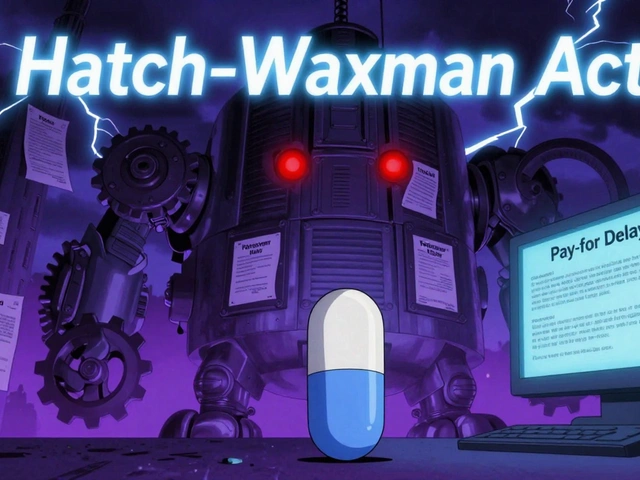
Lexapro vs. Antidepressant Alternatives Comparison Tool
Comparison Results
Select two medications and click Compare to see detailed information
Quick Reference Guide
Efficacy: Clinical studies show effectiveness varies by individual and condition.
Side Effects: Common include nausea, insomnia, and sexual dysfunction. Severity varies.
Drug Interactions: SSRIs and SNRIs can interact with other serotonergic drugs.
Onset of Action: Most patients see improvements within 4–6 weeks.
Cost: Generic versions available for most medications; insurance coverage varies.
If you’re weighing whether to stay on Lexapro or switch to something else, you probably have a list of questions buzzing in your head: How does it stack up against other drugs? What side‑effects should I expect? Which option fits my lifestyle best? This guide cuts through the noise by comparing Lexapro (Escitalopram) with the most common alternatives, so you can make an informed call without getting lost in medical jargon.
Key Takeaways
- Lexapro belongs to the SSRI class and is prized for its simple dosing and relatively low side‑effect profile.
- Prozac, Zoloft, Paxil, and Celexa are other SSRIs that differ mainly in half‑life, drug‑interaction risk, and weight‑change tendencies.
- Effexor and Cymbalta are SNRIs; they hit both serotonin and norepinephrine, which can help certain anxiety‑depression combos but may raise blood pressure.
- Wellbutrin works on dopamine and norepinephrine, making it a good pick for patients worried about sexual side‑effects or weight gain.
- Choosing the right medication hinges on three factors: symptom profile, personal health history, and how you handle side‑effects.
Below you’ll find a step‑by‑step look at each drug, a side‑by‑side table, and practical tips for talking with your prescriber.
How Lexapro (Escitalopram) Works
Lexapro is a selective serotonin reuptake inhibitor (SSRI) that blocks the reabsorption of serotonin in the brain, keeping more of the mood‑lifting neurotransmitter available. This action helps ease symptoms of major depressive disorder and generalized anxiety disorder. Lexapro’s half‑life is about 27‑32 hours, meaning once‑daily dosing usually keeps blood levels steady.
Because it’s the S‑enantiomer of citalopram, Lexapro delivers a more focused serotonin boost with fewer off‑target effects, which is why many patients report milder nausea and less sexual dysfunction compared with older SSRIs.
What to Compare When Looking at Alternatives
Before we jump into specific drugs, let’s outline the criteria that matter most for most patients:
- Efficacy for depression or anxiety - Does clinical data show the drug works for the condition you have?
- Side‑effect profile - Which unwanted effects are tolerable for you?
- Drug‑interaction risk - Are you on other meds that could clash?
- Onset of action - How quickly can you expect to feel better?
- Cost and insurance coverage - Is the medication affordable?
Keep these headings in mind as you scan the table later - they’re the decision levers you’ll actually use.
Major SSRI Alternatives
SSRIs share a core mechanism (blocking serotonin reuptake) but differ in chemistry, half‑life, and side‑effect nuance. Below are the most common choices.
Prozac (Fluoxetine)
Prozac is an SSRI with a long half‑life of 4‑6 days, making it a favorite for patients who travel frequently or worry about missed doses. It can feel a bit activating, which helps with low‑energy depression but may exacerbate anxiety for some.
Zoloft (Sertraline)
Zoloft is another SSRI often prescribed for both depression and panic disorder. Its half‑life is about 26 hours, similar to Lexapro, but it carries a slightly higher risk of gastrointestinal upset.
Paxil (Paroxetine)
Paxil offers strong anxiety relief, making it a go‑to for social anxiety and PTSD. However, its anticholinergic pull can lead to weight gain and sexual side‑effects, and it has a shorter half‑life (about 21 hours), so missed doses feel more noticeable.
Celexa (Citalopram)
Celexa is the racemic mixture that Lexapro is derived from. It’s generally well‑tolerated but at higher doses can affect the heart’s QT interval, a concern for patients with cardiac issues.
SNRIs - A Slightly Different Twist
If serotonin alone isn’t enough, you might consider an SNRI, which boosts both serotonin and norepinephrine.
Effexor (Venlafaxine)
Effexor works well for severe depression and chronic pain conditions. It tends to raise blood pressure at higher doses, so regular monitoring is recommended.
Cymbalta (Duloxetine)
Cymbalta is an SNRI approved for both depression and neuropathic pain. Its side‑effects often include dry mouth and mild insomnia, but many patients value the dual‑action for comorbid pain.
Non‑SSRI Options Worth Mentioning
When sexual dysfunction or weight change are deal‑breakers, a drug that works on different neurotransmitters can be a lifesaver.
Wellbutrin (Bupropion)
Wellbutrin targets dopamine and norepinephrine, so it rarely causes sexual side‑effects and can even aid smoking cessation. However, it may increase anxiety in a subset of patients, and seizure risk rises at higher doses.
Side‑by‑Side Comparison Table
| Drug | Class | Typical Dose Range | Half‑Life | Key Benefits | Common Side‑Effects |
|---|---|---|---|---|---|
| Lexapro | SSRI | 10‑20mg daily | 27‑32h | Low nausea, mild sexual dysfunction | Insomnia, dry mouth |
| Prozac | SSRI | 20‑60mg daily | 4‑6days | Activating, good for low energy | Agitation, appetite loss |
| Zoloft | SSRI | 50‑200mg daily | 26h | Broad anxiety coverage | GI upset, mild dizziness |
| Paxil | SSRI | 10‑40mg daily | 21h | Strong for panic & PTSD | Weight gain, sexual dysfunction |
| Celexa | SSRI | 20‑40mg daily | 35h | Well‑tolerated at low dose | QT prolongation (high dose) |
| Effexor | SNRI | 75‑225mg daily | 5h (extended‑release 11h) | Helps severe depression & pain | Blood pressure rise, nausea |
| Cymbalta | SNRI | 30‑60mg daily | 12h | Depression + neuropathic pain | Dry mouth, insomnia |
| Wellbutrin | NDRI | 150‑300mg daily | 21h | Low sexual side‑effects, weight neutral | Dry mouth, anxiety, seizure risk |

Which Alternative Fits Your Situation?
Imagine you’re sitting at a table with four plates. Each plate represents a medication, and the food on it aligns with what matters most to you.
- If you need steady blood levels even if you miss a dose, reach for the long‑half‑life option-Prozac.
- If sexual dysfunction is a deal‑breaker, Wellbutrin or low‑dose Celexa might be gentler.
- If you’re battling both depression and chronic pain, an SNRI like Cymbalta gives you dual coverage.
- If you have a history of heart rhythm issues, stay clear of high‑dose Celexa and talk to your doctor about a safer SSRI.
In practice, most prescribers start with an SSRI because of the extensive safety data. If you hit a snag-say, persistent nausea or loss of libido-they’ll switch you to another SSRI or jump to an SNRI or Wellbutrin.
Talking to Your Prescriber
Armed with this comparison, the conversation becomes easier. Here’s a quick checklist to bring to your appointment:
- Describe the main symptoms you want to target (depression, anxiety, pain, etc.).
- List any current meds, supplements, or over‑the‑counter products.
- Share side‑effects you’ve experienced with Lexapro (or never tried it).
- Ask about the onset timeline-when you can expect to feel a difference.
- Clarify cost: “Is there a generic version? What does my insurance cover?”
Most doctors appreciate concise, fact‑based questions. It shows you’ve done the homework and makes it easier for them to tailor a plan.
Potential Risks and How to Manage Them
All antidepressants carry a warning about increased suicidal thoughts in the first few weeks, especially for people under 25. If you notice worsening mood, call your doctor right away.
Other notable risks by class:
- SSRIs: Sexual dysfunction, weight change, potential serotonin syndrome if combined with other serotonergic drugs.
- SNRIs: Blood pressure spikes; monitor at baseline and after dose changes.
- Wellbutrin (NDRI): Seizure threshold lowers at doses above 300mg; avoid if you have a seizure history.
Regular follow‑up appointments (usually every 4‑6 weeks after a change) let you and your prescriber catch any issues early.
Frequently Asked Questions
Can I switch from Lexapro to another SSRI without a washout period?
Most clinicians do a direct cross‑tap because the half‑life of Lexapro is short enough that the drug clears within a few days. However, if you’ve been on a very long‑acting SSRI like Prozac, a brief washout may be recommended to avoid excess serotonin.
Is Lexapro safe during pregnancy?
Lexapro is classified as Category C, meaning risk cannot be ruled out. Doctors usually weigh the mental‑health benefits against potential fetal risks. If you’re pregnant or planning a pregnancy, discuss alternatives like certain non‑pharmacologic therapies first.
Why do I feel more energized after starting an SSRI?
SSRIs raise serotonin, which can boost mood and energy. Some people experience a slight stimulating effect, especially with drugs like Prozac. If it turns into agitation, a dose adjustment or switch to a more sedating option (like Paxil) may help.
How long should I stay on an antidepressant before deciding it works?
Typically 6‑8 weeks at a therapeutic dose is needed to gauge effectiveness. Some patients notice changes sooner, while others require the full trial period. If no improvement after 8 weeks, talk to your doctor about dosage tweaks or a different medication.
Can I combine Lexapro with Wellbutrin?
Yes, the combination is sometimes prescribed to offset sexual side‑effects of SSRIs. It’s called “augmented therapy,” and while generally safe, you’ll need monitoring for increased anxiety or insomnia.
Armed with the facts above, you can confidently compare Lexapro with its peers and decide which path feels right for your mental‑health journey. Remember, the best medication is the one that balances relief with tolerable side‑effects, fits your life rhythm, and keeps you moving forward.





8 Comments
The philosophical underpinnings of psychopharmacology demand rigorous scrutiny; one must consider not only the neurochemical mechanisms but also the sociopolitical ramifications of prescribing practices. Lexapro, as a selective serotonin reuptake inhibitor, epitomizes the modern pursuit of symptom remission through modulation of synaptic serotonin concentrations. Its pharmacokinetic profile, characterized by a half‑life of approximately twenty‑seven to thirty‑two hours, permits once‑daily dosing, thereby enhancing adherence among the citizenry. Yet, one cannot ignore the marginalization of alternative therapeutic modalities that arise when pharmaceutical solutions are exalted above psychosocial interventions. The comparative efficacy data, drawn from randomized controlled trials, reveal modest superiority over placebo, but the effect size remains bounded within a narrow confidence interval, suggesting limited clinical significance for certain subpopulations. Moreover, the adverse effect spectrum-insomnia, dry mouth, and occasional sexual dysfunction-must be weighed against the purported benefits, especially in a culture that prizes productivity over wellbeing. From a nationalist perspective, reliance on generic formulations produced domestically mitigates trade deficits and reinforces economic sovereignty, a factor often omitted from clinical guidelines. The cost–benefit analysis, therefore, extends beyond the individual to encompass national healthcare budgets and the allocation of resources toward preventive mental health strategies. In sum, while Lexapro offers a viable option for many, the decision matrix must integrate pharmacological data, patient preferences, socioeconomic context, and the broader ethical obligations of the medical profession.
Analyzing the data presented, the comparative table appears comprehensive but lacks weighted statistical significance for each endpoint. For instance, the side‑effect prevalence is listed without confidence intervals, making it difficult to assess true differences between Lexapro and the SNRI cohort. Additionally, the cost notation does not adjust for regional insurance formularies, which could skew perceived affordability. A more nuanced meta‑analysis would improve the reliability of the conclusions.
hey guys i totally get how overwhelming these choices can be i was on lexapro for a while and found the nausea not too bad but the dry mouth kinda bugged me lol maybe try starting low and see how u feel it really helps if u talk to ur doc early on
Interesting points made above about the half‑life differences
Those longer‑acting agents can be handy for people who travel a lot
From a coaching perspective, it is valuable to remind patients that consistent dosing and open communication with their prescriber are essential for achieving therapeutic goals.
Observing the trends, many users seem to gravitate toward SSRIs for their perceived safety profile, yet individual response variability remains a crucial factor.
While the guide is thorough, it glosses over the impact of concurrent substance use on metabolic pathways, particularly cytochrome P450 interactions that can alter plasma concentrations of both Lexapro and its alternatives.
One must consider the possibility that pharmaceutical giants manipulate clinical trial outcomes to favor patented SSRIs; hidden agendas often underpin the seemingly neutral data presented in such comparative tools.